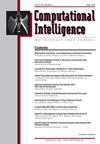模糊系统在医疗保健领域生物医学科学中的作用特刊客座编辑
IF 1.8
4区 计算机科学
Q3 COMPUTER SCIENCE, ARTIFICIAL INTELLIGENCE
引用次数: 0
摘要
由于生物医学数据具有弹性,人工神经网络(ANN)在生物医学和医疗保健领域面临挑战。这些数据需要一种以知识为中心的方法,而不是纯粹以数据为中心的方法。模糊系统可以有效处理医疗大数据中的模糊性,模拟人类的感知。这些系统可对各种医疗情况进行精确分析,中和疾病模式变化等不确定性。它们还支持根据健康属性对人群进行排序,有助于早期预后和预防医学。本特刊致力于关注模糊系统在医疗数据分析领域的最新进展和应用。它为研究人员提供了一个更有效地分享创新技术和方法的平台。通过本期杂志,我们希望激发讨论、促进合作,并在利用模糊系统对复杂的生物医学数据集进行更细致、更人性化的解释方面激发进一步的创新。随着技术的发展,医疗保健和诊断技术也在不断变化。纵观一系列创新方法,我们发现诊断领域明显倾向于深度学习和计算智能。例如,将计算智能用于分析 CT 图像以检测肺癌,以及使用极限学习机器算法对组织病理学图像中的肺癌进行分类的 XlmNet,都侧重于肺部疾病的早期检测。它们对复杂计算技术的依赖表明,我们正朝着更精确、更早期的诊断程序迈进。另一方面,我们还有像残差神经网络辅助单类分类这样的算法,专门用于在不平衡数据集中识别黑色素瘤。很明显,我们在有意识地努力解决类不平衡问题,这一直是医学图像分析中的一个障碍。心理健康和福祉也不甘落后。焦虑人群及其活动的智能分析 "和 "倦怠人群大脑图像的分类分析 "都强调了技术在理解和诊断心理健康问题中日益重要的作用。同样,肾脏疾病、视网膜问题、皮肤病变本文章由计算机程序翻译,如有差异,请以英文原文为准。
Guest Editorial on the Special Issue on the Role of Fuzzy Systems on Biomedical Science in Healthcare
求助全文
通过发布文献求助,成功后即可免费获取论文全文。
去求助
来源期刊

Computational Intelligence
工程技术-计算机:人工智能
CiteScore
6.90
自引率
3.60%
发文量
65
审稿时长
>12 weeks
期刊介绍:
This leading international journal promotes and stimulates research in the field of artificial intelligence (AI). Covering a wide range of issues - from the tools and languages of AI to its philosophical implications - Computational Intelligence provides a vigorous forum for the publication of both experimental and theoretical research, as well as surveys and impact studies. The journal is designed to meet the needs of a wide range of AI workers in academic and industrial research.
 求助内容:
求助内容: 应助结果提醒方式:
应助结果提醒方式:


